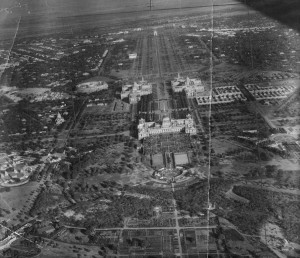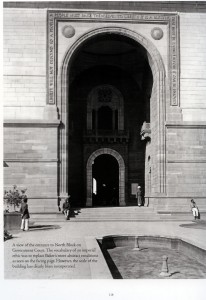Home / Design of Delhi: Edwin Lutyens
Design of Delhi: Edwin Lutyens
New Delhi and Edwin Landseer Lutyens (1869–1944)
The British response to the uprising of 1857 was to destroy much of the city Shah Jahan had built and to rename the Mughal monuments that remained after British monarchs. Overnight, Roshanara Bagh, the Mughal garden built by one of Shah Jahan’s daughters, became the Victoria Gardens. Half a century later, once the Mughal dynasty had ceased to be a threat to them, and when it had become clear that Calcutta was too chaotic to continue as the capital, the British made plans to move their headquarters back to the traditional seat of government in India.
On December 15, 1911, King George V and Queen Mary laid the foundation stone for New Delhi, and did so, ironically, at a darbar modeled on that of the Mughals, under a purposely built Shah Jahani dome. The message was clear: the British were the legitimate successors of the Mughals and their new capital was intended to express the power of the Raj, just as Shah Jahan’s capital had expressed the authority of the Mughals.

An aerial view of the completed city of New Delhi with the war memorial at the end of Kingsway. Photo courtesy of Centre for South Asian Studies, University of Cambridge
The construction of the new city was an epic project involving no less than 29,000 laborers. Yet one man masterminded every aspect of the construction, from the shape of the doorknobs in the Viceroy’s palace, to the types of flowers suitable for planting in the roundabouts. Edwin Lutyens was a self-taught, working-class genius of ethnic Dutch origins. After winning the commission to construct the new capital, Lutyens was presented with the biggest architectural opportunity offered to any British architect since his hero, Sir Christopher Wren, set about rebuilding London after the Great Fire.
Lutyen’s Delhi was the last great construction project to be completed by the British in India. It is one of the supreme achievements of British architecture in any period of history, and still ranks as one of the most elegant urban landscapes anywhere in the world. As the 1930’s aesthete and writer Robert Byron wrote when he saw it for the first time, “People don’t realize what has been done, how stupendous it is, and such a work of beauty, so unlike the English.”
New Delhi was to be the capital of the Raj for only sixteen years, fulfilling the ancient prophecy that says that any ruler who builds a new city in Delhi will lose it. In 1947 the British returned to their island when the Indians won their freedom, and New Delhi became the capital of an independent India.


